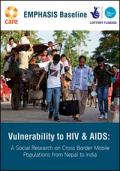Publications - Released in 2011
In Nepal, people in low economic brackets with minimal productive means are influenced by the political instability and are likely to migrate. The Nepal Living Standard Survey conducted by the Central Bureau of Statistics in 2003/04 has estimated that one million Nepalese work in India mostly as unskilled permanent or seasonal laborers and domestic workers. According to The Peace and Friendship Treaty signed between India and Nepal in 1950, citizens of both countries can travel and work freely across the border and are to be treated the same as native citizens – except for voting rights. Cross border migrants, due to poverty, lack of legal protection, poor access to services, discrimination and exploitation face many vulnerabilities, particularly related to HIV & AIDS. Data from studies in Nepal estimate that 46% of HIV cases in Nepal were among seasonal migrants to India.
This report presents the findings of a baseline study carried out in India and Nepal for CARE's Enhancing Mobile Population’s Access to HIV & AIDS Services, Information and Support (EMPHASIS) program. This program seeks to reduce the vulnerability of mobile populations to HIV & AIDS along two mobility routes between Bangladesh and India and Nepal and India. The objectives of this study were to understand the vulnerabilities faced by mobile populations by exploring the volume, pattern and drivers of mobility.
Downloads
Organizations
- CARE






